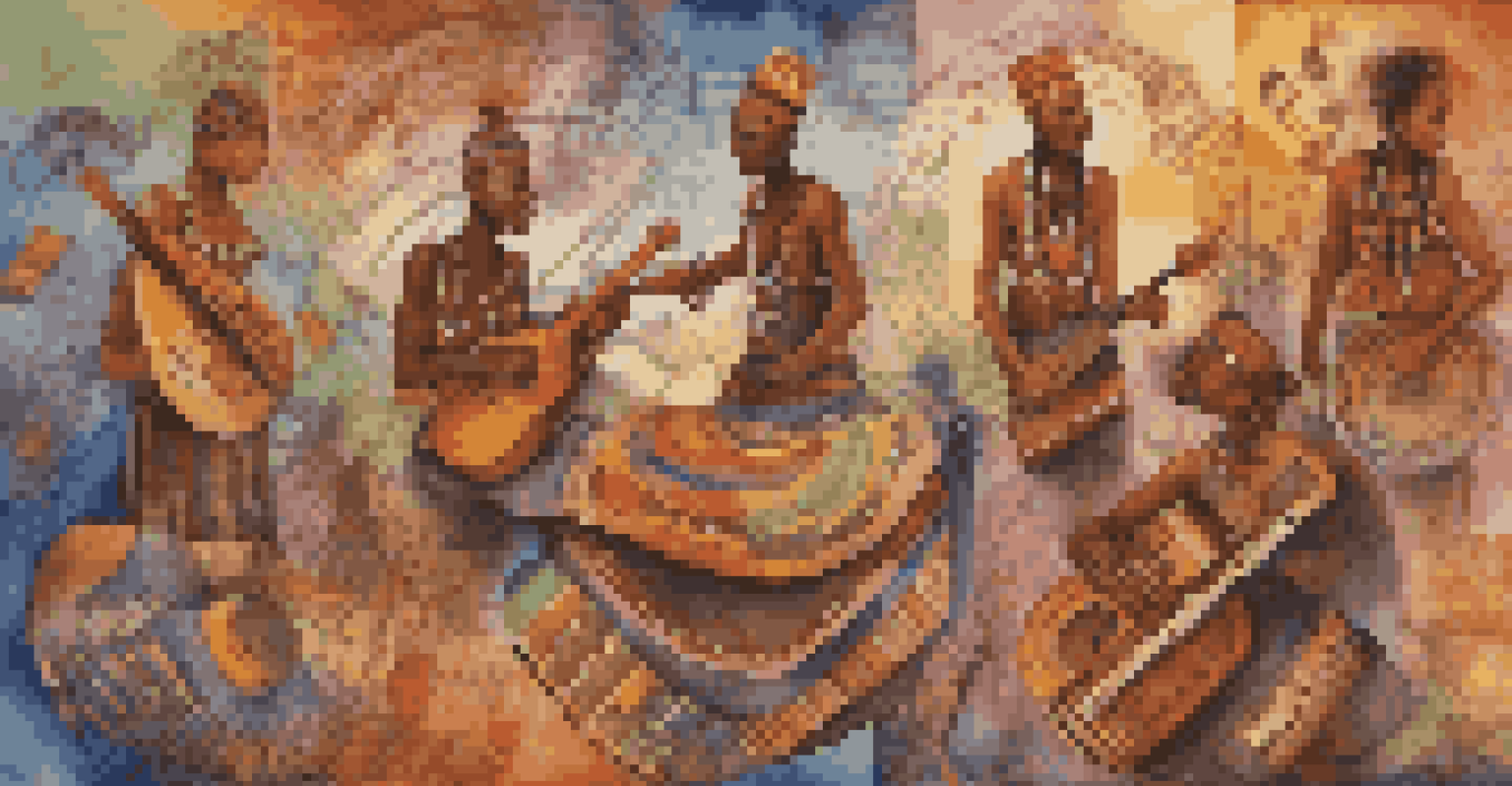Incorporating World Music Elements in Your Compositions

Understanding the Essence of World Music
World music encompasses a rich tapestry of sounds and traditions from various cultures. It often includes unique instruments, rhythms, and scales that can add depth to your compositions. By understanding its essence, you can infuse authenticity into your music while celebrating global diversity.
Music is the universal language of mankind.
Think of world music as a colorful palette, each culture contributing its own shade. For example, the intricate rhythms of African drumming can provide a vibrant backdrop, while the haunting melodies of Indian classical music can evoke deep emotions. This fusion not only enriches your work but also connects listeners to different cultural narratives.
As you explore world music, consider what resonates with you personally. Whether it's the soulful strumming of a Brazilian bossa nova or the energetic beats of a Middle Eastern folk dance, finding your connection will inspire your creativity and guide your compositions.
Exploring Instruments from Around the Globe
Incorporating unique instruments can instantly elevate your music. From the sitar of India to the djembe of West Africa, each instrument brings its own character and sound. Experimenting with these instruments can create a fresh sonic experience that captivates your audience.

Imagine blending a traditional Irish fiddle with contemporary pop elements. The contrast can create a unique sound that stands out in today's music scene. By embracing these diverse instruments, you not only enhance your compositions but also expand your musical vocabulary.
Embrace Global Music Influences
Incorporating diverse musical elements from around the world can enrich your compositions and connect listeners to various cultural narratives.
When introducing new instruments, consider how they interact with your existing sound. Layering these elements thoughtfully can lead to innovative arrangements that maintain coherence while exploring new territories. It's about creating a dialogue between different sounds that resonates with your listeners.
Rhythmic Variations: Embracing Global Rhythms
Rhythm is the heartbeat of music, and incorporating global rhythms can add excitement and dynamism to your compositions. Each culture has its own distinctive rhythmic patterns that can inspire creativity. For instance, the complex polyrhythms found in African music can invigorate a simple melody.
The beauty of music is that it brings people together, transcending boundaries and cultures.
Consider how different time signatures, such as the 7/8 time of Balkan music, can shift the feel of your piece. This can introduce an element of surprise that keeps your listeners engaged. By experimenting with these variations, you can break away from conventional structures and create something truly unique.
As you integrate these rhythms, pay attention to how they influence the overall flow of your composition. The interplay between traditional rhythms and your original ideas can create a rich tapestry of sound that resonates deeply with your audience.
Melodic Influences: Using Scales from Different Cultures
Scales are the building blocks of melody, and exploring different cultural scales can open up new creative pathways. For example, the pentatonic scale is prevalent in many Asian musical traditions and can evoke a sense of tranquility. This can serve as a refreshing contrast to Western scales that dominate contemporary music.
Using these scales allows you to create melodies that feel both familiar and exotic. By incorporating elements like the Arabic Hijaz scale, you can add a touch of the mysterious to your compositions. It’s all about blending these influences to create something that feels fresh and innovative.
Respect Cultural Context
Understanding and honoring the traditions behind world music elements is essential to avoid cultural appropriation and enhance authenticity in your work.
Don’t hesitate to mix scales within a single piece. This can lead to intriguing harmonic progressions that surprise and delight your listeners, enriching their experience while showcasing your versatility as a composer.
Vocal Techniques: Exploring Global Singing Styles
Vocal techniques vary widely across cultures, and incorporating these styles can add a unique flavor to your compositions. For instance, throat singing from Mongolia creates a mesmerizing sound that can mesmerize audiences. By embracing these techniques, you can enhance the emotional impact of your music.
Consider how the call-and-response technique found in African music can engage your listeners. This interactive approach invites participation and creates a communal atmosphere. It's a powerful way to transform a performance into an experience that resonates deeply with your audience.
As you explore these vocal styles, think about how they can complement your instrumental work. The fusion of diverse vocal techniques with your musical ideas can lead to innovative arrangements that capture the essence of world music.
Cultural Context: Respecting Traditions in Your Work
When incorporating world music elements, it's crucial to respect the cultural context from which they originate. Understanding the significance of these musical traditions helps you avoid cultural appropriation and fosters authenticity in your work. This respect enriches your compositions and honors the heritage of the music you draw from.
Researching the history and significance of the musical elements you wish to incorporate can provide invaluable insights. For instance, knowing the story behind a specific folk song can inform your arrangement and allow you to capture its spirit. This kind of understanding not only enhances your music but also connects you to a broader narrative.
Experimentation is Key
Gradually blending different musical styles encourages creativity and innovation, allowing for unique and captivating compositions.
Engaging with musicians from different cultures can also deepen your understanding and appreciation. Collaborating with diverse artists can lead to unexpected and beautiful fusions of styles, allowing you to learn directly from the traditions you admire.
Practical Tips for Blending Styles Seamlessly
Blending different musical styles can be challenging, but it can also be incredibly rewarding. Start by identifying specific elements you want to incorporate, such as a rhythm, scale, or instrument. By focusing on these elements, you can create a cohesive sound that feels both original and respectful to the traditions.
One effective approach is to gradually introduce world music elements into your work. Begin with subtle influences, like incorporating a specific rhythm, before expanding to more complex integrations. This gradual approach not only helps maintain coherence but also allows your creativity to unfold naturally.

Finally, don't be afraid to experiment and make mistakes along the way. Every great composition comes with its fair share of trial and error. Embrace the process, and you'll find that blending world music elements can lead to exciting new avenues in your creative journey.